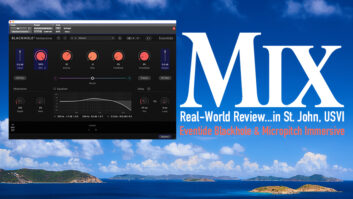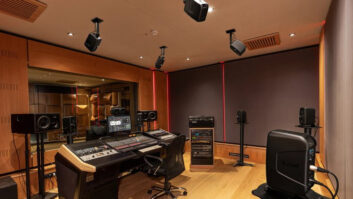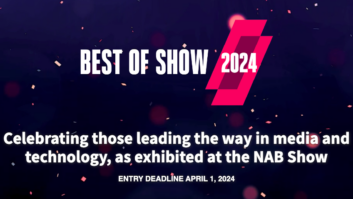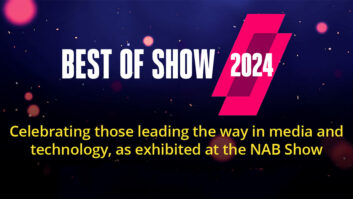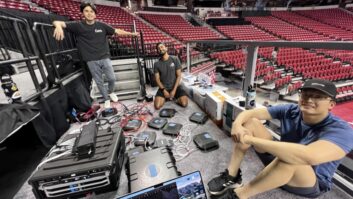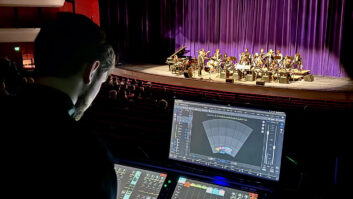London, UK (July 12, 2019)—Scheduled to close on July 27 at London’s Saatchi Gallery, Beyond The Road is described as an immersive exhibition that attempts to merge the worlds of visual art, music and film, offering attendees the opportunity “to lose themselves in a multi-sensory world led by sound.”

The multimedia exhibition was developed by creative producer Colin Nightingale and sound designer/creative director Stephen Dobbie, both part of the core crew at Punchdrunk, in collaboration with electronica composer James Lavelle from UNKLE. All sound playback is handled by d&b audiotechnik processors and loudspeakers, while one key exhibit features the innovative use of a d&b Soundscape immersive surround-sound system. Accompanying 3D holographic displays are realized via a series of HYPERVSN systems fed from a central server that holds high-resolution video and graphics files.
The art installation comprises a reconstruction of audio and visual elements from two UNKLE albums—The Road: Part I and The Road: Part II/Lost Highway—multichannel stems of which were used to create a multi-sensory experience over the gallery’s entire top floor. “Bespoke sound design was created especially for the space by contemporary artists and filmmakers,” Dobbie explained to PSN in an exclusive interview. Guest artists and filmmakers included Danny Boyle, Jonas Burgert, Nathan Coley, Alfonso Cuaron, Toby Dye, Doug Foster, Azzi Glasser and John Stark.
Nightingale and Dobbie become part of Punchdrunk in 2002, and formed the creative team that worked on such shows as Sleep No More, New York (2011-19) and Sleep No More, Shanghai (2016-19), The Drowned Man: A Hollywood Fable (2013-14) and Masque of the Red Death (2007-8).
The basic concept for Beyond The Road was first initiated about two and a half years ago, Dobbie recalled: “We had the opportunity to work closely with the composer, James Lavelle, and to develop visual ideas with a number of innovative artists. In essence, we curated the sound and visual elements to re-imagine James’ music in a new way, while developing combinations we thought would work within the large, open space that was put at our disposal by The Saatchi Gallery. We had three weeks in which to build the performance spaces in the gallery’s sound-isolated top floor.”
The multi-element exhibition comprises a number of individual gallery areas that feature synchronized sound and video playback. “After the build, we spent a week remixing the soundtracks in situ for each individual space,” Dobbie continued. “A d&b DS100 64-in/64-out processor handles software-controlled routing of discrete audio sources to a total of 75 loudspeaker channels, with some material being sourced from paralleled outputs. Key channels are reserved for The White Room, where we included dynamic panning via Soundscape to place constantly moving sound around the attendees, using object-based En-Scene software to re-create the mix within the geometry of the target gallery space.” The White Room features three films: The Lost Highway by Warren du Preez and Nick Thornton Jones; The Road by Norbert Schoener; and clips from Roma, directed by Alfonso Cuaron, and courtesy of Netflix. Room design and color-shifting projection was by BeyondProjects.
Soundscape uses object-based techniques and vector panning to provide fully programmable horizontal sound fields that can also be overlaid with user-selectable ambiences to mimic familiar performance spaces. Several console and show-control system manufacturers offer direct control of the DS100 DSP Engine, with positioning settings and object parameters controllable directly from on-surface channels, and stored within an on-board scene memories.
According to Wayne Powell, d&b audiotechnik’s manager of market development, “In some spaces, the project uses a combination of the DS100 matrix functionality with OSC automation, with the addition of En-Scene mixing and En-Space room emulation engines for [The White Room], one of the featured spaces. The DS100’s 64 matrix outputs are fed via a DS10 Dante-to-AES3 digital network bridge to Model D20 amplifiers that power a selection of E4 and E8 of loudspeakers, as well as E12X-SUB and B6-SUB subwoofers.”
In terms of design and configuration of The White Room’s loudspeaker layout, “DS100 early-reflection planes and positioning views, amplifier patch and the [Audinate] Dante preset file were all achieved in ArrayCalc V10 software,” Powell stated. “The gallery’s sound designers are using a combination of d&b’s R1 remote-control software, [Figure 53] QLab and [Cockos Incorporated] Reaper playback workstations to achieve a desired soundscape for the space. A network was built from the main control room to several racks incorporated into the design. Use of the DS100 and Dante allowed control and audio data to be send via this network throughout the entire exhibition floor.”
“We are seeking to reinvent how people experience and interact with music, which became an environment that visitors are free to explore,” Nightingale stated. “The exhibition includes the work of visual designer and multimedia artist Tupac Martir of Satore Studio and Satore Tech. All the visual artists we invited to participate have been involved in the creative world of James Lavelle through soundtracks, music videos and album artwork,” for the latter’s albums.
After years of working together on tours, the creative team began to discuss aesthetics and new technologies. “We started talking about the concept some two years ago,” Martir recalled. “Once it became obvious that my idea needed to be both a part of the live show and art, we began to see what could be possible with the technology at hand. Music is the driving force of the exhibition and of the piece, so it is very important for us to allow the music to create the environment.” Martir’s piece, entitled “Eriya” or “to feel” in the indigenous Mexican language of Huichol, centers around holographic dancers moving around the viewer, using Notch software and HYPERVSN holographic displays.
“Our overarching design philosophy was simple,” Dobbie acknowledged. “We believe that ‘Less is More,’ to the extent that an audience can feel more with reduced, minimal sound and visuals.” Nightingale added, “For us, sound is 90% of the experience, and so we wanted to re-imagine music in an innovative way, with visuals that compliments the artists’ ideas.”
“We’ve been dreaming of finding new ways to present music for many years,” Dobbie concluded. “We were excited to create a project with sound at its core, pushing technology to its limits in this performer-less experience [while] engaging with audiences through a holistic approach to what art and culture can be.”
Beyond The Road • www.saatchigallery.com/art/beyondtheroad_faqs.php
d&b audiotechnik • www.dbaudio.com
